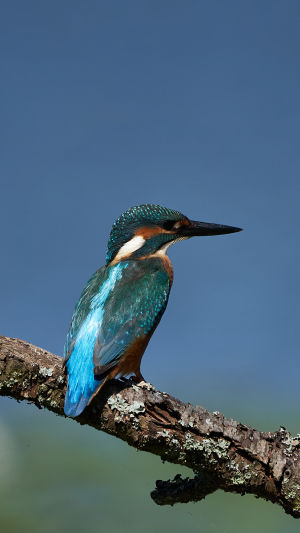Most kingfishers are short and short and fat, the size of a sparrow, with a body length of about 15 cm.
The kingfisher is one of the most abundant and widely distributed birds in the kingfisher family.
In their native environment, kingfishers in either region have a common habit of choosing water.
Since the kingfisher's main food is small fish, roosting near water ensures an adequate food source.
The kingfisher is not only active at the water's edge, but its nesting sites are also near water sources.
Usually, kingfishers prefer to nest on steep slopes high above the river or on earthen slopes close to the water.
Once there is a fish in the water, it can quickly locate the fish and then rush towards it at a speed of up to 90 km per hour to hit it with its beak.
Since kingfishers fly extremely fast when hunting, often we see a kingfisher hunting is that the reed it stays on sways gently.
And the next second it is already holding the fish and flying away.
Kingfishers are solitary birds, and they are solitary except during the breeding season, when the kingfisher will have both males and females together to nest and incubate their eggs.
Habitually, kingfishers are alert, have good eyesight and, crucially, fly extremely fast, making them very difficult to catch and kill artificially.
Kingfishers are small birds and do not have much meat.
Therefore, the decline of kingfishers is not a human trapping.
So, why are they rare? There are two reasons.
1.The reduction of food
In the past, when you go to a small river in the wild, fish can be seen everywhere.
However, in recent years, there are fewer and fewer fish in the field water bodies, for two reasons.
One is drought. The frequent summer droughts in recent years have led to the depletion of water sources in many wild bodies of water.
The other is the artificial capture.
Nowadays, where there are fish in the wild, there are human requirements.
If it is simply fishing, it is not too much of a threat to the survival of fish.
But some people use poisonous fishing methods to catch fish, which led to the death of both large and small fish all.
And once the kingfisher ate the poisoned fish, then its fate is the same as the fish.
Only one way to die. For the kingfisher, which feeds mainly on fish, the lack of food has led to a gradual decline in their numbers.
2. Petting
Although kingfishers have escaped capture by humans, they are highly ornamental due to their very beautiful plumage.
Therefore, many kingfishers are captured as pets.
However, since kingfishers mainly eat fish, and the fish they eat must be freshly caught by themselves.
Moreover, kingfishers are omnivorous birds, and they eat insects, frogs and aquatic plants in addition to fish.
This way the kingfisher will have balanced nutrition and healthy growth.
Therefore, it is difficult to feed, which leads to many captured kingfishers dying under feeding.
It is true that the kingfisher population has declined so much compared to the past that it has become extinct in many places.
The main reasons for the decline of kingfishers are drought and the decrease of food.
However, wild kingfishers can still be found in some areas with good ecological conditions.
Therefore, the number of kingfishers reflects to a certain extent the quality of the regional water environment.





